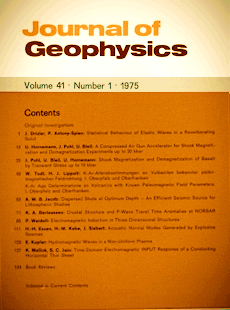Dispersed shots at optimum depth - an efficient seismic source for lithospheric studies
Article Sidebar
Published:
Jan 3, 1975
Keywords:
Dispersed underwater explosions,
Seismic source,
Seismic long range profiles
Volumes

Vols. 1-18 (1924-1944), ISSN 0044-2801
Main Article Content
A.W.B. Jacob
Institute of Geological Sciences, Edinburgh UK
Abstract
The case for dispersing charges fired at sea into a number of packages fired simultaneously at optimum depth is outlined and an experiment, carried out to check that linear addition of the signals from separate sources does occur, is described. The advantages of this system for lithospheric studies are demonstrated.
 ARK: https://n2t.net/ark:/88439/y018705
ARK: https://n2t.net/ark:/88439/y018705
Permalink: https://geophysicsjournal.com/article/97
Article Details
How to Cite
Section
References
Berg, J.W., Long, L.T., Sarmah, S.K., Trembly, L.D. (1971) Crustal and Mantle Inhomogenieties as Defined by Attenuation of Short-Period P waves. AGU Monograph 14:51-57
Bonjer, K.P., Kaminski, W., Kind, R. (1974) Seismic Observations in Germany of a 10 ton Explosion off Scotland. J. Geophys. 40:259-264
Hirn, A., Perrier, G., Steinmetz, L. (1974) 10 Ton Explosion off Scotland 1972 observed in the distance range 900 to 1500 km in France. Compt. rend. (In press)
Jacob, A.W.B. (1970) Long range observations of underwater explosions. Proc. Geol. Soc. (London) 1662:82-83
Jacob, A.W.B., Willmore, P.L. (1972) Teleseismic P Waves from a 10 Ton Explosion. Nature 236:305-306
O'Brien, P.N.S. (1967a) Quantitative Discussion on Seismic Amplitudes produced by explosions in Lake Superior. J. Geophys. Res. 72:2569-2575
O'Brien, P.N.S. (1967b) The Efficient use of large charges, in Seismic Refraction Prospecting. In: Seismic Refraction Prospecting. A. W. Musgrave, ed., pp. 152-170. S. E.G., Tulsa, Oklahoma
Wielandt, E. (1972) Anregung seismischer Wellen
Willis, H.F. (1941) Underwater explosions, time interval between successive explosions. British Report WA-47-21
Bonjer, K.P., Kaminski, W., Kind, R. (1974) Seismic Observations in Germany of a 10 ton Explosion off Scotland. J. Geophys. 40:259-264
Hirn, A., Perrier, G., Steinmetz, L. (1974) 10 Ton Explosion off Scotland 1972 observed in the distance range 900 to 1500 km in France. Compt. rend. (In press)
Jacob, A.W.B. (1970) Long range observations of underwater explosions. Proc. Geol. Soc. (London) 1662:82-83
Jacob, A.W.B., Willmore, P.L. (1972) Teleseismic P Waves from a 10 Ton Explosion. Nature 236:305-306
O'Brien, P.N.S. (1967a) Quantitative Discussion on Seismic Amplitudes produced by explosions in Lake Superior. J. Geophys. Res. 72:2569-2575
O'Brien, P.N.S. (1967b) The Efficient use of large charges, in Seismic Refraction Prospecting. In: Seismic Refraction Prospecting. A. W. Musgrave, ed., pp. 152-170. S. E.G., Tulsa, Oklahoma
Wielandt, E. (1972) Anregung seismischer Wellen
Willis, H.F. (1941) Underwater explosions, time interval between successive explosions. British Report WA-47-21











